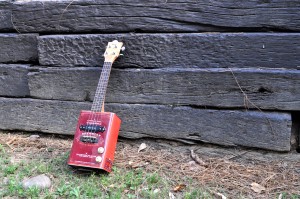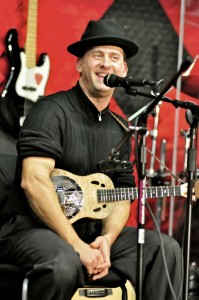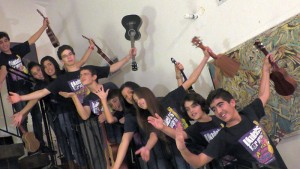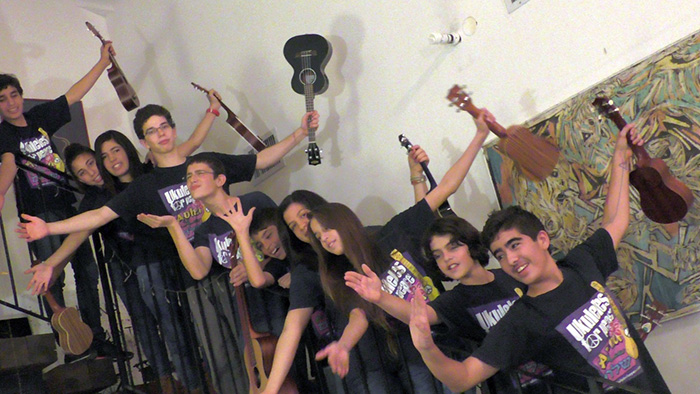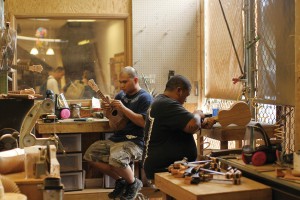
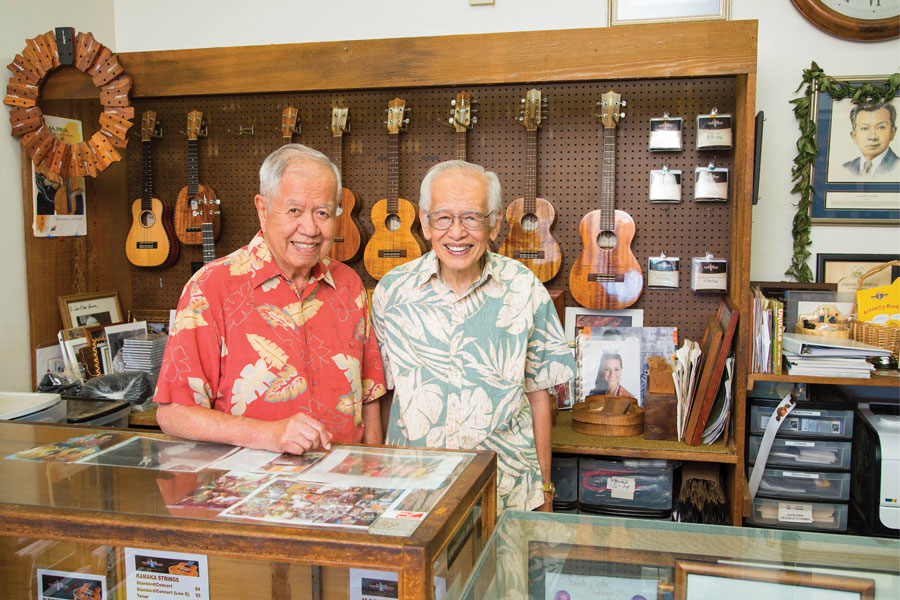
Samuel Kamaka Jr., left, and Frederick Kamaka Sr.
By Adam Perlmutter
Since the 1990s boom, the ukulele has become a global phenomenon, enthusiastically played by musicians everywhere from Great Britain to Thailand, in an incredible range of contexts. Meanwhile, the ukulele is still thriving in its place of origin, Hawaii, where it maintains its status as the state instrument.
It’s hardly surprising that some of the world’s best ukuleles are still made in Hawaii. And it happens that four preeminent makers whose names begin with K—Kamaka, Kanile`a, Ko`olau, and KoAloha—are based on Hawaii’s third-largest island, Oahu, “The Gathering Place.”
Between the four companies, you’ll find a ukulele in any style, from the most traditional bell-shaped soprano to an unusual hand-carved tenor archtop, with prices ranging from $100 to more than $10,000.
All of the shops are open to the public and clustered relatively close together, no two more than 25 miles apart, and the closest two are a scant two miles from each other. So on that next trip to Hawaii, you might find yourself visiting all of the makers and coming home with one—or four—playable souvenirs.
Kamaka is the oldest and most storied of the four K’s, established in 1916 when Samuel Kaialiilii Kamaka began making ukuleles and guitars in the basement workshop of his Honolulu home. By the mid-1920s, Kamaka had set up a shop outside of his home, at which, among many other things, he invented the pineapple body that is today a standard alternative to the traditional bell shape. A decade later, as demand for his instruments grew, he enlisted the help of his two sons, Samuel Jr. and Frederick, then only grade-school students.
After the elder Kamaka died in 1953, Samuel Jr. took over the business and saw it through periods of rapid expansion during the next couple of decades. Frederick joined the company as its general business manager in 1972, after retiring from a career with the U.S. Army. In turn, the next generation of Kamakas was drafted into the company. Samuel Jr.’s son Chris is now the production manager, and his other son Casey builds custom orders; Frederick’s son, Frederick Jr., is the business manager.
These days, the 29-employee company makes about 3,000 instruments per year, with stock models ranging from $895 to $2,495, all up to the lofty standards established almost 100 years ago by the senior Kamaka. “My grandfather always stressed that the bottom line is the sound of the instrument,” says Chris Kamaka. “It’s so rewarding for us to continuing making ukuleles, carefully and using the highest-quality materials, that live up to the family name.”
Kamaka makes nine different ukulele models: standard; standard pineapple; concert; four-, six-, and eight-string tenors; baritone; standard deluxe; and concert bell-shaped deluxe. All stock models have soundboards, backs, and sides made of koa; mahogany necks; and rosewood fretboards and bridges. The instruments are highly regarded for their full sound and durability of construction. “People bring in old Kamaka ukuleles for repair, some of which my grandfather made. Unless [an amateur repairer] has messed with them, because they’re so well built, it’s usually easy for us to take them apart and get them back to playable condition,” says Kamaka.
The company also offers custom ukuleles, but due to high demand, it’s not presently accepting orders for these instruments. However, it is fulfilling orders for Specials—stock instruments that are semi-customizable, with upgrades like AAA or AAAA koa, spruce soundboards, wood or shell rosettes, ebony fretboards and bridges, fretboard inlays, long necks, and passive or active electronics. The wait time for these instruments is about three to four months—but worth it. Kamaka says, “You get a personalized ukulele that will be with you for a long, long time.”
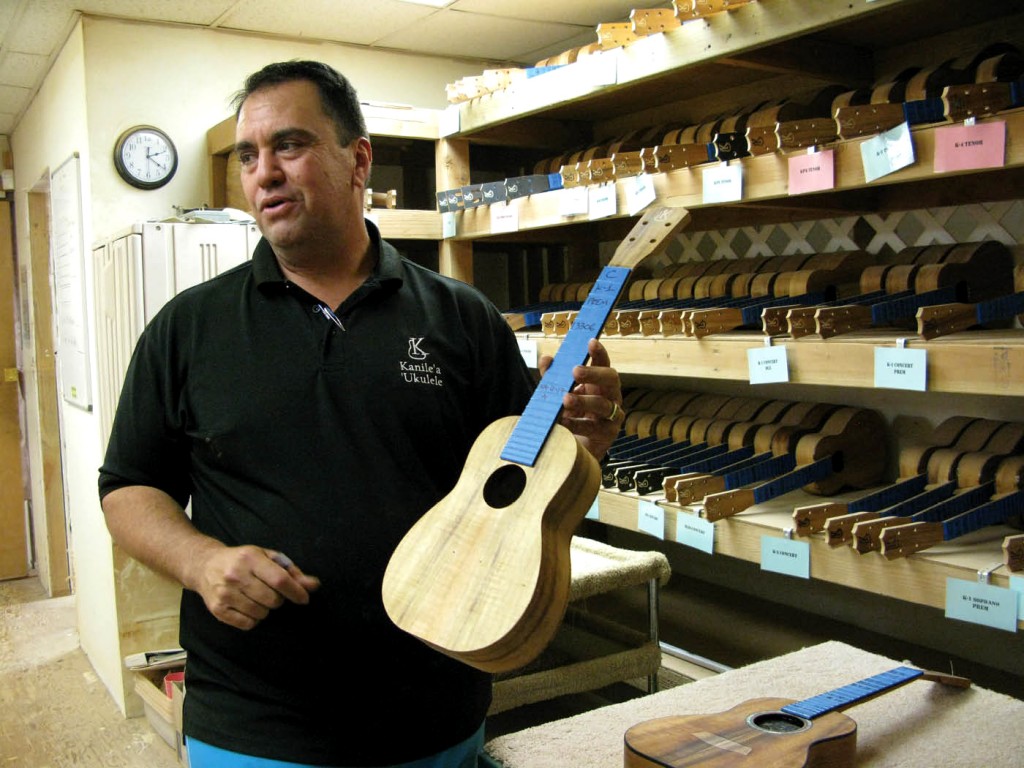
Joe Souza of Kanile`a
Kanile`a is headquartered in Kaneohe, a census-designated place within Honolulu. Like the three other K’s, it’s a family-based company, led by Joe Souza, the instrument maker, and his wife, Kristen, who handles customer sales and accounting. “We complement each other really well,” says Souza. “I might be the builder, but Kristen, taking care of the administrative duties, is really the backbone of the company.”
Like most, if not all, natives of Hawaii, Souza was exposed to plenty of ukulele and guitar singalongs in his formative years. Though he was required to play ukulele as part of his elementary school education, it wasn’t until high school that he got serious on the instrument. In 1991, at the age of 20, Souza took a pivotal apprenticeship with the master luthier Peter Bermudez. Souza says, “I had no way of knowing how important learning from ‘Uncle Pete’ would be in my life and career.”
Almost 25 years later, Souza, a master luthier himself, oversees his team of 21 employees in building about five to six professional-grade ukuleles per day, or 1,400 per year. The instruments range in price from $700 to $3,000, while the company’s budget ukuleles, imported under the Islander name, cost between $100 and $600. All Kanile`a ukuleles are distinguished by special processes from start to finish. For one, the company mills its own wood. “We start with felled koa trees, waxing and letting them start the drying process right there in the forest before being air-dried in our shop,” says Souza, adding that the company participates in an active reforestation program.
Kanile`a instruments have a proprietary bracing system that takes into account not just the forward/backward and left/right movement of a vibrating soundboard, but also the up/down movement. Kanile`a’s TRU bracing is essentially a truss system in which tone bars pass underneath the braces. “TRU stands for ‘total resonating ukulele,’” explains Souza. “It takes a lot more work [than traditional bracing], but the end result is worth it for its enhanced sound and stability.”
Instead of the traditional lacquer, each Kanile`a ukulele receives an ultraviolet-cured finish, similar to the one Taylor Guitars pioneered in the mid-1990s, which has both aesthetic and environmental benefits. “Our finish is hardened under ultraviolet light or sunlight. Unlike [nitrocellulose lacquer], it stretches when the instrument is exposed to temperature changes, and so it tends not to check. And with the finish, we’ve eliminated VOCs [volatile organic compounds]. From the way we source our wood to this finishing method, we care deeply about the environment.”
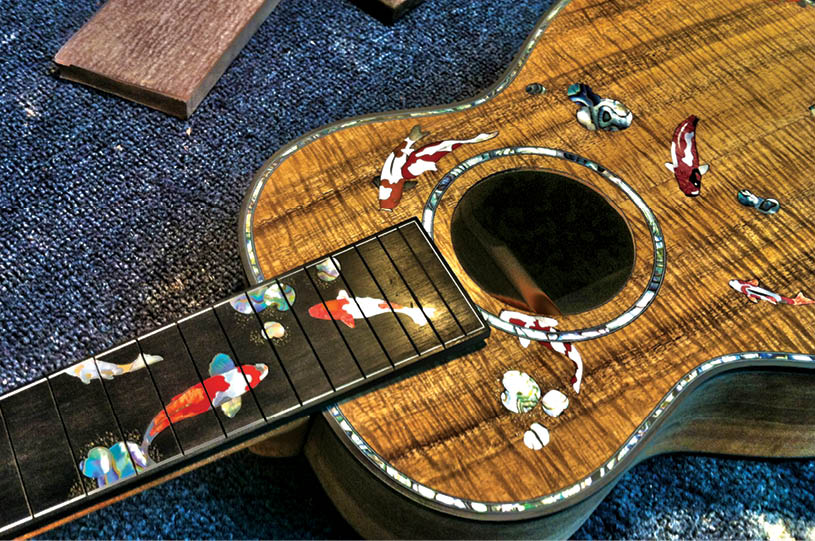
Ko`olau
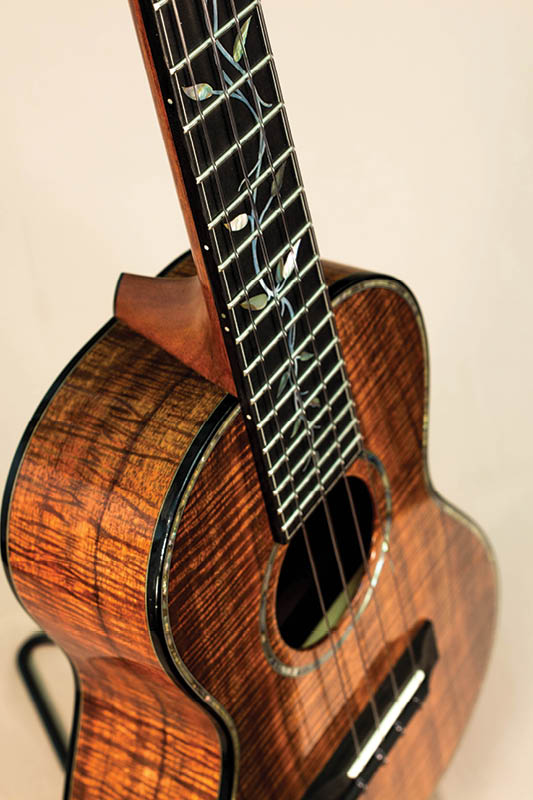
Ko`olau
Ko`olau, whose shop is situated in the scenic area between the Ko`olau and Waianae Mountains, is presided over by luthier John Kitakis. Kitakis began tinkering with guitar repair 50 years ago, while still in his teens. After studying furniture making at a university in Washington in the 1970s, he embarked on his professional life as a furniture craftsman and restorer of antique furniture, setting things up nicely for his next business venture repairing stringed instruments of all types. Kitakis says, “I deliberately did not put emphasis on building new because I saw a great demand for repair and restoration. And besides fulfilling that demand, I wanted a job, and repair is not what most luthiers want to do. Much like an old house, no one really wants to fix them, but they do it for both the challenge and job security. Along the way, customers brought me more and more guitars, mandolins, banjos, and ukuleles to fix. And then asked me to make new ones.”
Eventually, Kitakis was joined by his sons, Noa and Andrew, repairing guitars for Martin, Gibson, Taylor, and other major manufacturers, as well as custom-making guitars and mandolins. In the mid-1990s, the clan started the Ko`olau Guitar and Ukulele company, with an emphasis on high-end instruments. “From the beginning, we decided to do what no one had done so far in the world of ukulele manufacturing,” says Kitakis. “Namely, really high-quality, regardless of the cost, and regardless of whether anyone would eventually pay the price.”
Plenty of performers—from old-timers like Lyle Ritz and Benny Chong to modern players like Abe Lagrimas and Craig Brandau—have, in fact, paid the price. But, acknowledging those with lesser means, in 2005 Ko`olau introduced its Pono line of affordable, all-solid-wood ukuleles and guitars, designed in Hawaii and built in Indonesia.
Ko`olau offers what are perhaps the most adventurous designs of the four K’s. In addition to standard bell- and pineapple-shaped models, its lineup includes such bold instruments as cutaway, semi-hollow tenor and baritone electrics, and a hand-carved tenor archtop with cat’s-eye f-holes. Though the Ko`olau team uses plenty of koa in its instruments, it builds with a wider range of tonewoods than its Hawaiian counterparts—including native tropical ash and Brazilian rosewood for the backs and sides, and Adirondack spruce and redwood for soundboards.
Ko`olau’s custom instruments are its most tantalizing offerings. The company makes between 300 and 400 per year, starting at $1,600 and, in the case of, say, a tenor archtop with fancy inlays, costing as much as $13,000. The construction time is between eight and 12 months, and involves extensive dialogue between the makers and the buyers. “The process of building a custom instrument is a long, detailed, and collaborative process,” says Kitakis. “So, we understand and actually invite customers to feel a part of the process. We want clear communication, and in the end, complete understanding and satisfaction.”
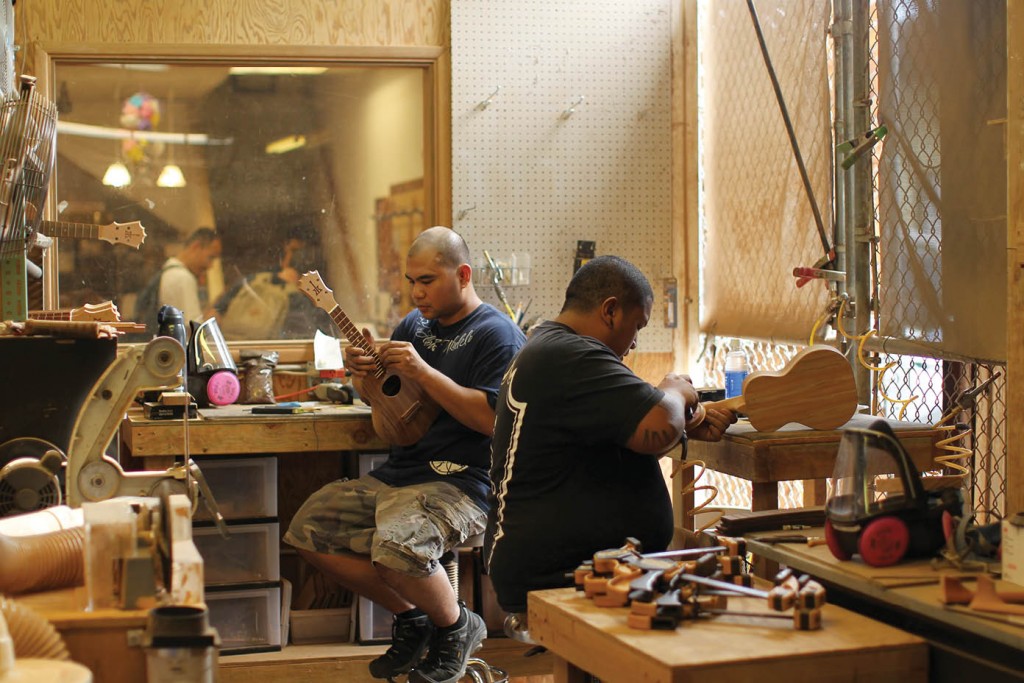
Dennis Hermano, left, and Albert Tagama work in KoAloha’s factory.
Based in Honolulu, KoAloha is also a relatively new manufacturer. Established in the mid-1990s, the patriarch of this family-based company is Alvin “Pops” Okami, an inventor and musician who once owned a thriving plastics factory. When the factory went bust in the early 1990s, Okami reinvented himself as a maker of tiny playable ukuleles before moving on to full-size ones, and soon, other family members joined the business.
Today, “Pops” is the senior vice president of the company, and Pat “Moms” Okami is the treasurer; son Alan is the president, and son Paul is vice president and master luthier. “We try to adhere to the family atmosphere in all areas of our business,” says Alan Okami. “We eat together each day and host guests from time to time to join us. Our goal is to have anyone feel the same whether they enter our shop or if we take a promotion on the road.”
KoAloha is a portmanteau of the words koa and aloha, and true to its name, the company makes predominant use of koa in the construction of its instruments. Boasting vibrant sound and excellent projection, these ukes can be heard by players such as Daniel Ho and Victoria Vox. KoAloha’s instruments are, for the most part, traditional, with soprano, concert, and tenor models available in standard or pineapple shapes. (Long necks are an option on smaller-bodied models.)
While KoAloha instruments have a classic lively sound, they depart from tradition in aesthetic ways—sometimes radically so. A model called the Sceptre—sort of the B.C. Rich of ukuleles—borrows its unusually pointy silhouette from an ornamental staff. The ukes in KoAloha’s new Naupaka line (see page 90) utilize a unique combination of koa and mango wood throughout their entire bodies—tops, sides, and backs. In other cases, the distinctive touches are subtler.
The company’s signature headstock is in the shape of a five-point crown, sometimes mirrored at the upper edge of the fretboard, and the standard soundhole shape is inspired by a local foodstuff. “Our musubi soundhole is definitely unique to our brands,” says Okami, referring to the popular snack in which a ball of rice is wrapped in a slice of grilled Spam and tied together with dried seaweed.
There’s a KoAloha uke for every budget, with an Indonesian-made entry line (KoAlana) and Thailand-made mid-level line (KoAloha Opio) supplementing its flagship Hawaiian-made line. Prices for standard sopranos in these lines range from $175 to $800, but instruments produced in the company’s custom shop—Red Label (non-commissioned) and Black Label—can go for as much as $4,000. And they’re quite coveted. “Our Black Labels have an approximate backlog of three years,” explains Okami.
“Our Red Labels are probably the best way to purchase a custom uke, but they are often sold as soon as they are produced”—a good indication that the current ukulele craze is showing no signs of abating.
This article originally appeared in the Fall 2015 issue of Ukulele magazine. Click here for more on that issue.

 http://ukulele.io/Buy21Songs Learn to play ukulele the easy way with "21 Songs in 6 Days". And visit our website for more great ukulele lessons, tabs, and a FREE ebook http://ukulele.io/free-stuff-offer
http://ukulele.io/Buy21Songs Learn to play ukulele the easy way with "21 Songs in 6 Days". And visit our website for more great ukulele lessons, tabs, and a FREE ebook http://ukulele.io/free-stuff-offer
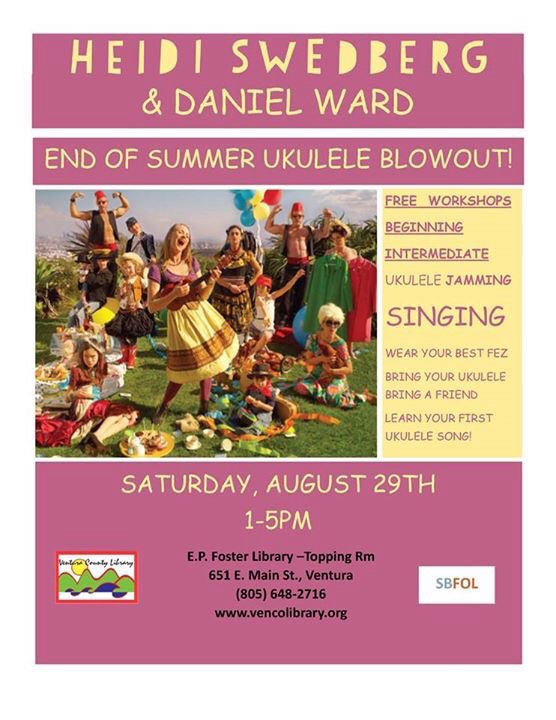

 http://youtu.be/EQz4ElEpd_4 Bridge Over Troubled Water
http://youtu.be/EQz4ElEpd_4 Bridge Over Troubled Water






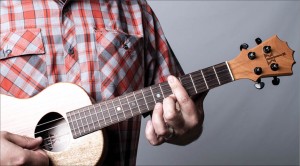
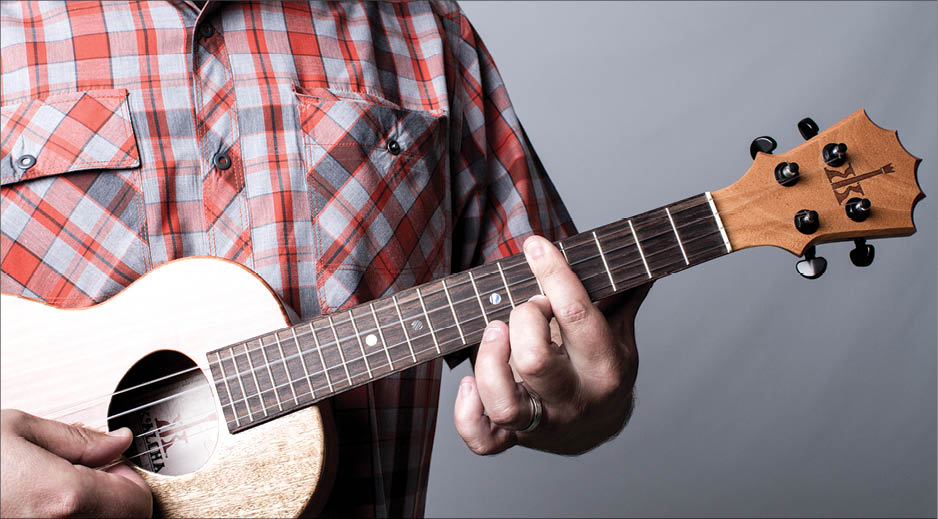
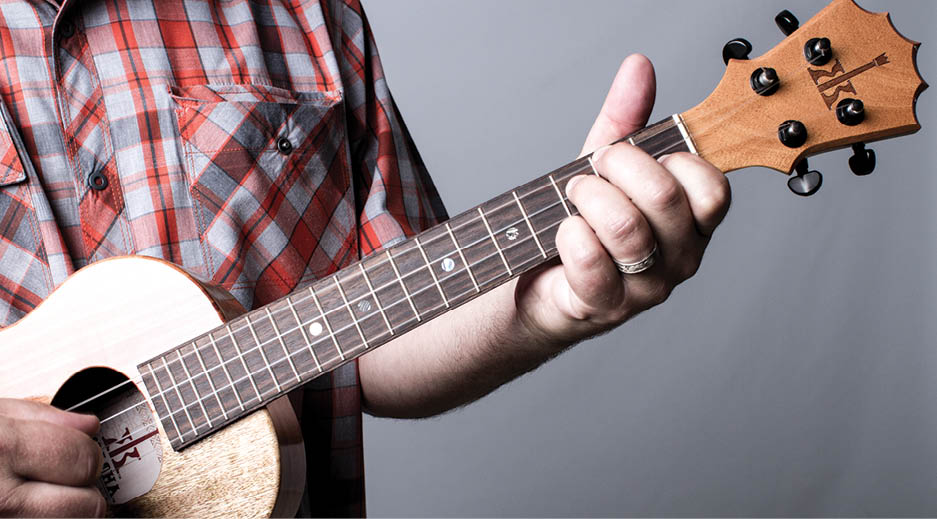

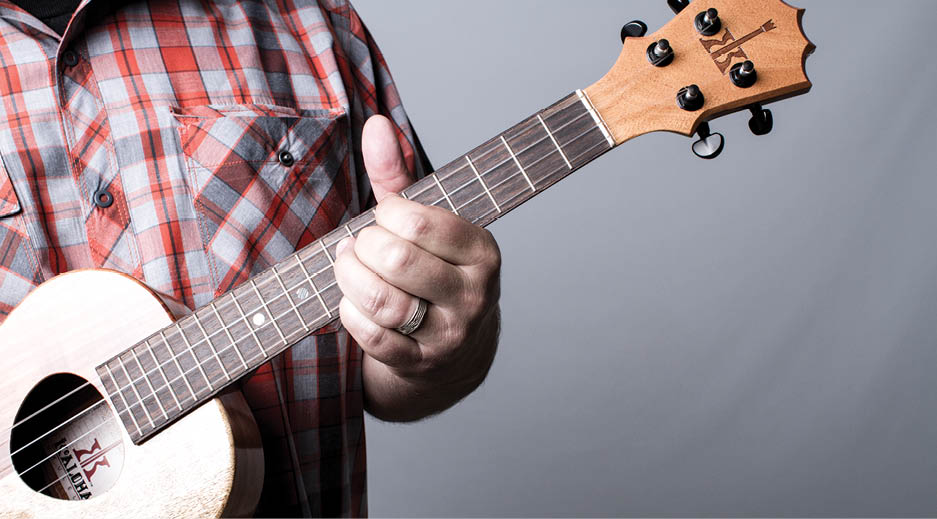

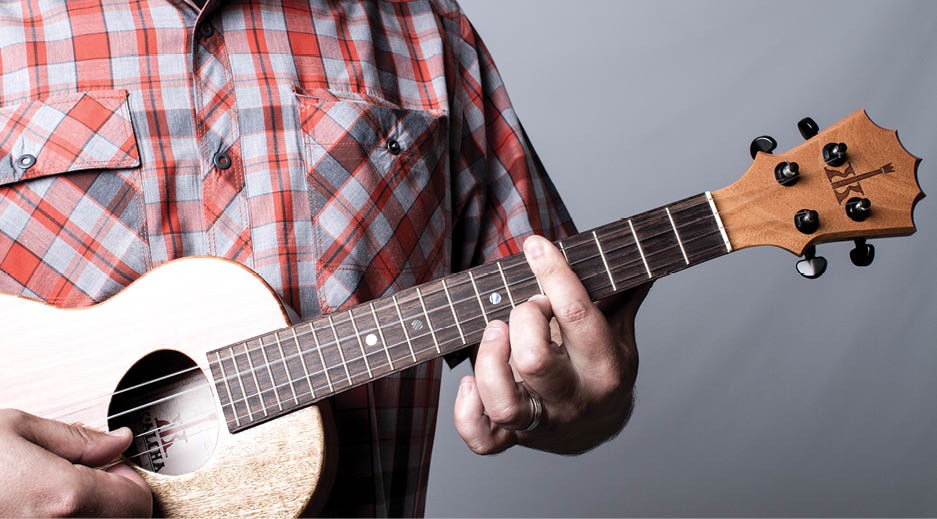

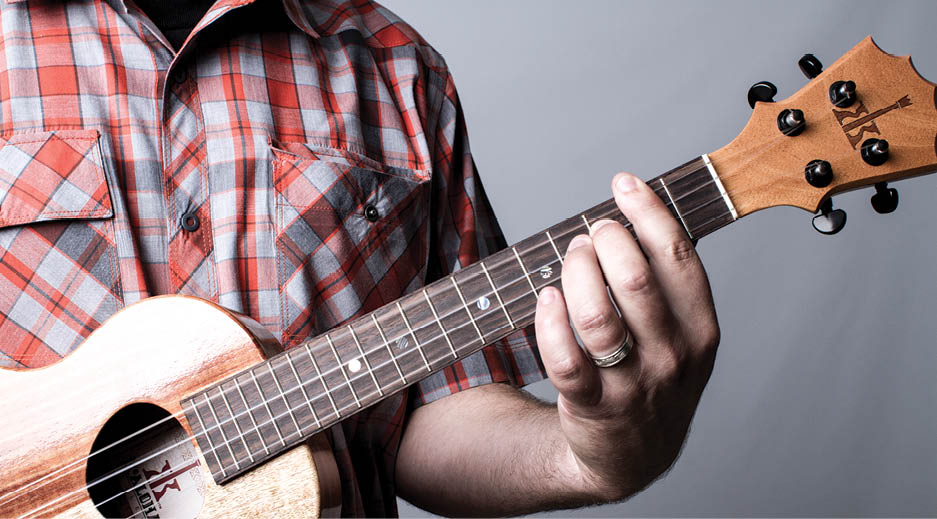


 http://ukulele.io/Buy21Songs Learn to play ukulele the easy way with "21 Songs in 6 Days". And visit our website for more great ukulele lessons, tabs, and a FREE ebook http://ukulele.io/free-stuff-offer
http://ukulele.io/Buy21Songs Learn to play ukulele the easy way with "21 Songs in 6 Days". And visit our website for more great ukulele lessons, tabs, and a FREE ebook http://ukulele.io/free-stuff-offer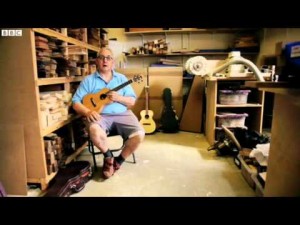

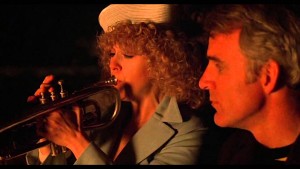
 http://ukulele.io/Buy21Songs Learn to play ukulele the easy way with "21 Songs in 6 Days". And visit our website for more great ukulele lessons, tabs, and a FREE ebook http://ukulele.io/free-stuff-offer
http://ukulele.io/Buy21Songs Learn to play ukulele the easy way with "21 Songs in 6 Days". And visit our website for more great ukulele lessons, tabs, and a FREE ebook http://ukulele.io/free-stuff-offer